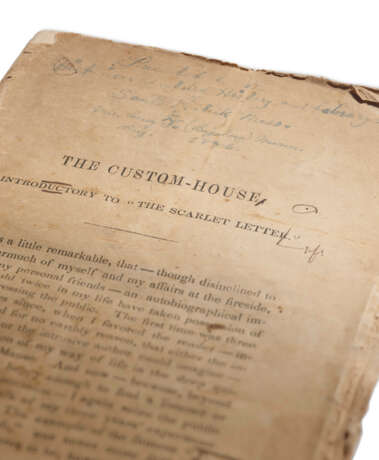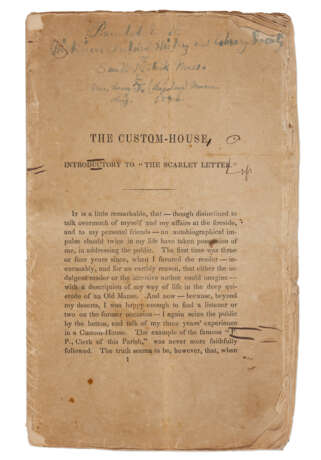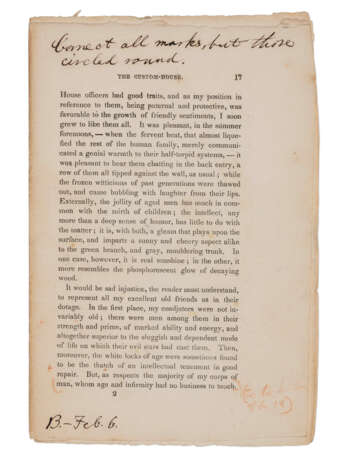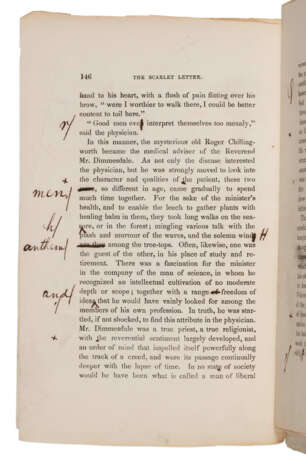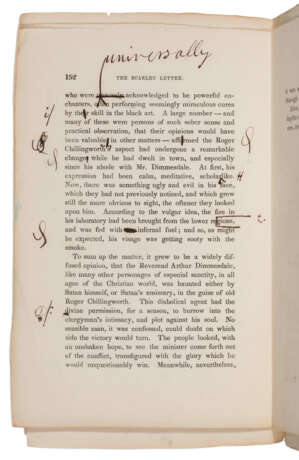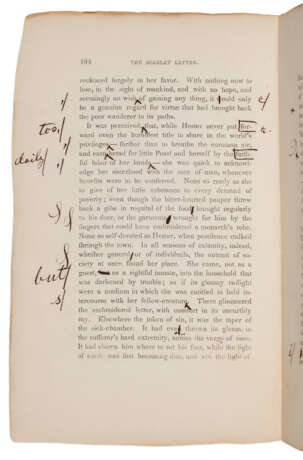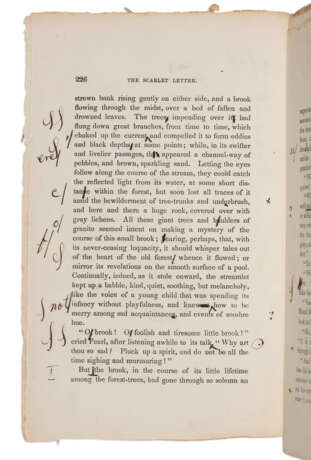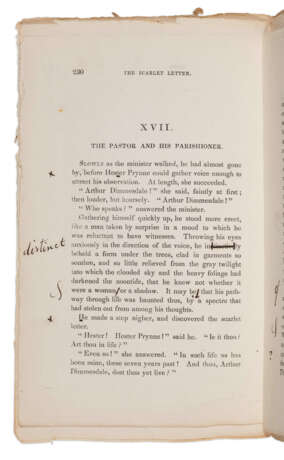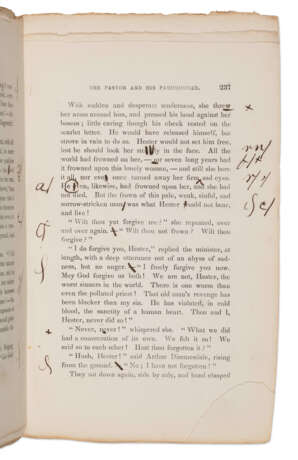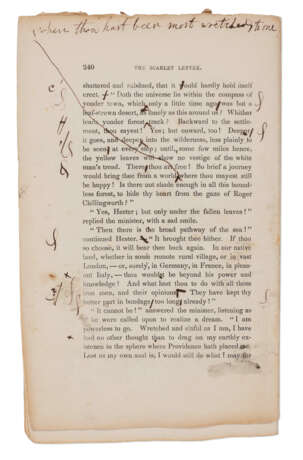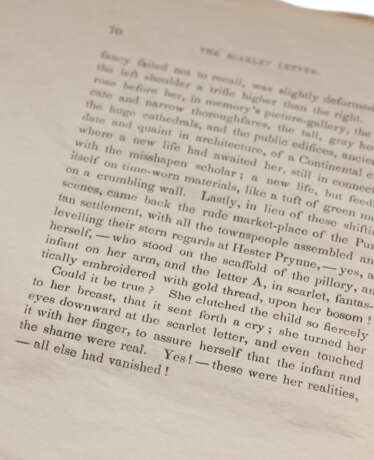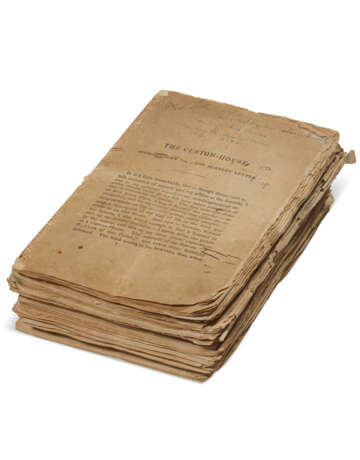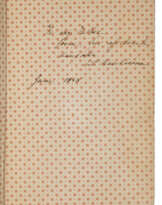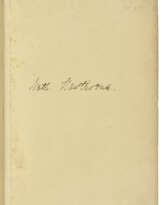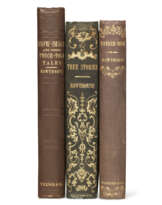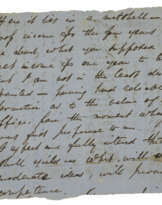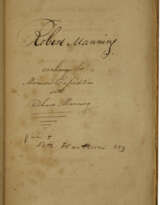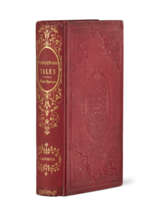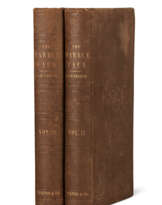ID 967606
Los 89 | The Scarlet Letter corrected page proofs
Schätzwert
$ 600 000 – 800 000
Nathaniel Hawthorne, 1850
HAWTHORNE, Nathaniel (1804-1864). Annotated printed page proofs for The Scarlet Letter [Salem, Massachusetts, 1850].
"[T]hese corrected proofs are as close as we can come to the entire original work—the greatest achievement of the man whom Herman Melville extolled as “the American, who up to the present day, has evinced, in literature, the largest brain with the largest heart.” —Hawthorne scholar Richard Kopley
"Unique and remarkable evidence": Hawthorne's own pre-publication annotated page proofs for his masterpiece, with his corrections and emendations on over 140 pages (Kopley). Author's proofs for 19th-century works are incredibly rare on the market, as they were typically discarded during the publication process. Regarding the original manuscript for the novel, Hawthorne famously stated on more than one occasion that it had been destroyed: "burnt" and sent "up the chimney." The only surviving piece is his autograph manuscript leaf for the title-page and table of contents, which resides at the Morgan Library. As such, until the discovery of these proofs by the Natick Historical Society in the early 2000s, the sole text for the novel had been the first printing of the first edition—these corrected proofs are as close as we can come to the original work. Hawthorne scholar Richard Kopley notes: "Unique and remarkable evidence for the proofing process for Hawthorne’s masterpiece emerges in twenty quires [...] We have, thereby, new access to the publication of Hawthorne’s classic, about which Henry James wrote, 'In fact, the publication of The Scarlet Letter was in the United States a literary event of the first importance. The book was the finest piece of imaginative writing yet put forth in the country [...] It is beautiful, admirable, extraordinary'" (Hawthorne, 111).
In Nathaniel Hawthorne's 15 January 1850 letter to his publisher, "My dear Fields," he sends him, "at last" all but three chapters of the manuscript to The Scarlet Letter. Of what would be his best-selling and most famous work he writes: "I have been much delayed by illness in my family and other interruptions. Perhaps you will not like the book nor think well of its prospects with the public. If so (I need not say) I shall not consider you under any obligation to publish it. 'The Scarlet Letter' is rather a delicate subject to write upon, but in the way in which I have treated it, it appears to me there can be no objections on that score." He goes on to explain the function of the introductory "Custom House," directing "so please read it first"; his 20th January letter would further describe it as "an entrance-hall to the magnificent edifice which I throw open to my guests."
Once he finished the novel, he reported "tremendous terms of approbation," from both Fields and his wife, Sophia. In his 4 February 1850 letter to Horatio Bridge, he reports reading the ending to Sophia the night before: "It broke her heart and sent her to bed with a grievous headache—which I look upon as a triumphant success!" He continues, "Judging from its effect on her and the publisher, I may calculate on what bowlers call a 'ten-strike.' Yet I do not make any such calculation. Some portions of the book are powerfully written; but my writings do not, nor ever will, appeal to the broadest class of sympathies, and therefore will not attain very wide popularity."
Crucially, in his 15 January letter to Fields, Hawthorne includes a telling post-script: "P.S. The proof-sheets will need to be revised by the author. I write such an infernal hand that this is absolutely indispensible." Indeed, on approximately 144 pages, in clear, dark ink, Hawthorne has made some 650 corrections to alignment, spelling, punctuation, and capitalization, and in 38 instances, his emendations are substantive. Kopley notes, "We have in these proofs a range of careful emendations, from spacing and line-breaks to words and sentences." A full list is available on request. Examples include page 146, where he has deleted two words and added “-anthem” to yield the powerful image “and the solemn wind-anthem among the tree-tops”; page 152, where he has altered “unwisely” to “universally,” so that it reads in full: “Two or three individuals hinted, that the man of skill, during his Indian captivity, had enlarged his medical attainments by joining in the incantations of the savage priests; who were universally acknowledged to be powerful enchanters, often performing seeming miraculous cures by their skill in the black art”; and page 240, where he adds the phrase, “where thou has been most wretched to me.” Printer’s corrections in the text comprise some 90 corrections, all accidentals, made in orange-red pencil. In a note on page 17 (the first page of the second gathering) Hawthorne directs the printer to “correct all marks but those circled round”; thereafter, a number of the printer’s suggested alterations are circled by Hawthorne. Several gatherings bear a 21 February date, explained by the delay of three chapters Hawthorne mentions in his 15 January letter to Fields noted above.
The first leaf bears the fading inscription: "Presented to the Historical Natural History and Library Society of South Natick Mass, by Mrs. Lucy T. (Bigelow) Mann. Aug. 1886." Nathaniel Hawthorne's sister-in-law Mary Tyler Peabody joined the Mann family with her marriage to Horace Mann in 1843. Lucy Train Bigelow (1819-1901) married Jonathan Bacon Mann (1817-1904) in May 1845 in Natick, Massachusetts. BAL 7600; Clark A16.1; Grolier American 59.
Octavo (192 x 115mm). Uncut and unbound, printed on rectos only for proofing, folded in 20 gatherings; without pp. i-iv, the title and contents leaves, which were evidently printed later (toning to first and final leaves, a little fraying to edges, occasional minor soiling, some corners creased, pp.237 and 245 with small losses to margins, pp. 321 and 322 detached from gathering with mended tears). Custom folders housing each gathering in modern red morocco box. Provenance: Mrs Lucy Train Bigelow Mann, 1819-1901 (given to:) – Historical Natural History and Library Society of South Natick Mass. (sold at:) – Christie's New York, 16 December 2004, lot 554.
| Künstler: | Nathaniel Hawthorne (1804 - 1864) |
|---|---|
| Kategorie des Auktionshauses: | Gedruckte Bücher |
| Künstler: | Nathaniel Hawthorne (1804 - 1864) |
|---|---|
| Kategorie des Auktionshauses: | Gedruckte Bücher |
| Adresse der Versteigerung |
CHRISTIE'S 20 Rockefeller Plaza 10020 New York Vereinigten Staaten | ||||||||||||||
|---|---|---|---|---|---|---|---|---|---|---|---|---|---|---|---|
| Vorschau |
| ||||||||||||||
| Telefon | +1 212 636 2000 | ||||||||||||||
| Fax | +1 212 636 4930 | ||||||||||||||
| Nutzungsbedingungen | Nutzungsbedingungen | ||||||||||||||
| Versand |
Postdienst Kurierdienst Selbstabholung | ||||||||||||||
| Zahlungsarten |
Banküberweisung | ||||||||||||||
| Geschäftszeiten | Geschäftszeiten
|
